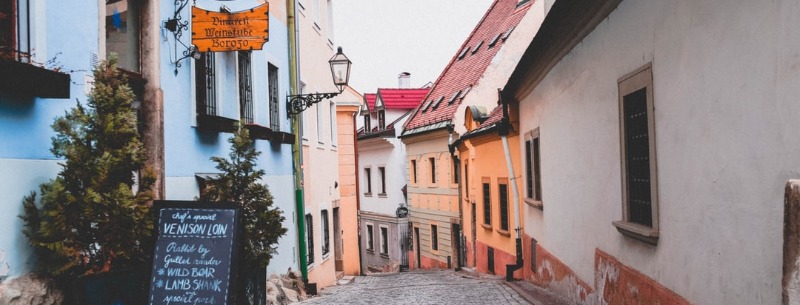Bratislava, capital city of Slovakia
Bratislava is a delightful mix of new, old and downright historic. The city center is crisscrossed with winding cobblestone roads, candy-colored 18th-century rococo buildings, pedestrian plazas and welcoming street cafes. Venture outside the center, and you will see bizarre communist constructions and block after block of institutional housing. The skyline’s most prominent feature is an age-old castle, but it is nearly overshadowed by a 1970s bridge that looks like a UFO. That is Bratislava, where the city is constantly evolving while still holding on to its rich past.
The Bratislava Castle dominates the Slovakian capital, watching over it from its perch on an isolated rocky hill. The original structure was built in the 11th century but underwent major reconstruction to reflect the Gothic style in 1423. Other renovations followed until a devastating fire destroyed the castle in May 1811. For 150 years, the charred ruins sat untouched until the last round of reconstruction began in 1968. Today, many parts of the castle are open to the public, including exhibitions of the Slovak National Museum and the extensive gardens.
Just below the castle sits St. Martin’s Cathedral, a stunning example of Gothic architecture and one of Slovakia’s oldest churches. Since 1204, the cathedral has been the coronation church of many Hungarian kings and today is one of the Old Town’s highlights. Other notable churches in the area include the beautiful Church of St. Elisabeth, the Church of the Holy Savior, the church of the Annunciation and St. Clare’s Church, now used as a concert hall.
On the other side of the castle’s hill is the Slavin monument and cemetery, dedicated to the Soviet soldiers who died during the city’s liberation battle in World War II. Quiet and serene, it is a great place to escape the city crowds and enjoy one of the best views of Bratislava.
St. Michael’s Gate is another must-see for Bratislava visitors. In medieval times, the city was protected by fortified walls and exit and entry were possible only through four gates. St. Michael’s Gate still stands today, topped with an impressive statue of the saint himself. The nearby Museum of Medieval Fortification is also worth a visit for its fascinating collection of arms.
Bratislava is home to many other interesting museums, including the Natural Science Museum, the Museum of Transport and the Jewish Community Museum, featuring a large collection of rare ritual tools, photographs and artifacts from the Holocaust.
For a relaxing morning or afternoon, head to Europe’s oldest public park, Sad Janka Krala. Students from the nearby campus congregate at the cafes and pubs, and footpaths take visitors down the lovely banks of the Danube.
One of the best times to visit the city is in December, when the Christmas Market fills the Old Town with seasonal sights and smells. Bratislava’s market is smaller than those in Vienna and Prague, but it is also much more traditional, friendly and family-oriented. Do not leave without sampling the Christmas treats, including potato pancakes filled with goose fat and garlic, roasted pork sandwiches and spicy red or white mulled wine.
Classical music lovers should not miss a performance by the world-renowned Slovak Philharmonic Orchestra at the historic Reduta building. For even more cultural indulgence, catch an opera, ballet or theater performance at the historical venues that line the Danube.
Bratislava Geographical Location
Bratislava is located in the southwest of Slovakia near the borders of Austria and Hungary.
The population of Bratislava is approximately 650,000 and is Slovakia’s largest city.
Bratislava Language
Slovak is the official language of Slovakia with a large percentage also speaking Hungarian. There are many minority languages that hold co-official status in areas that have 20% or more of the population speaking it.
Bratislava Predominant Religion
- 69% Roman Catholic
- 13% None
- 11% Protestant
- 4% Greek Catholic
- 3% Other
Although most of the population identify themselves as Roman Catholics, only about one third attend church services regularly.
Bratislava Currency
The Slovak Koruna is the official currency of Slovakia.
Bratislava Climate
Bratislava experiences four seasons with cold winters and hot summers. It is often windy throughout the year with moderate and consistent rainfall.
Bratislava Main Attractions
- Old Town
- Bratislava Castle
- St Martin’s Cathedral
Other Attractions in Bratislava
- St Elizabeth’s Church
- Primatial Palace
- Grassalkovich Palace
- Devin Castle
